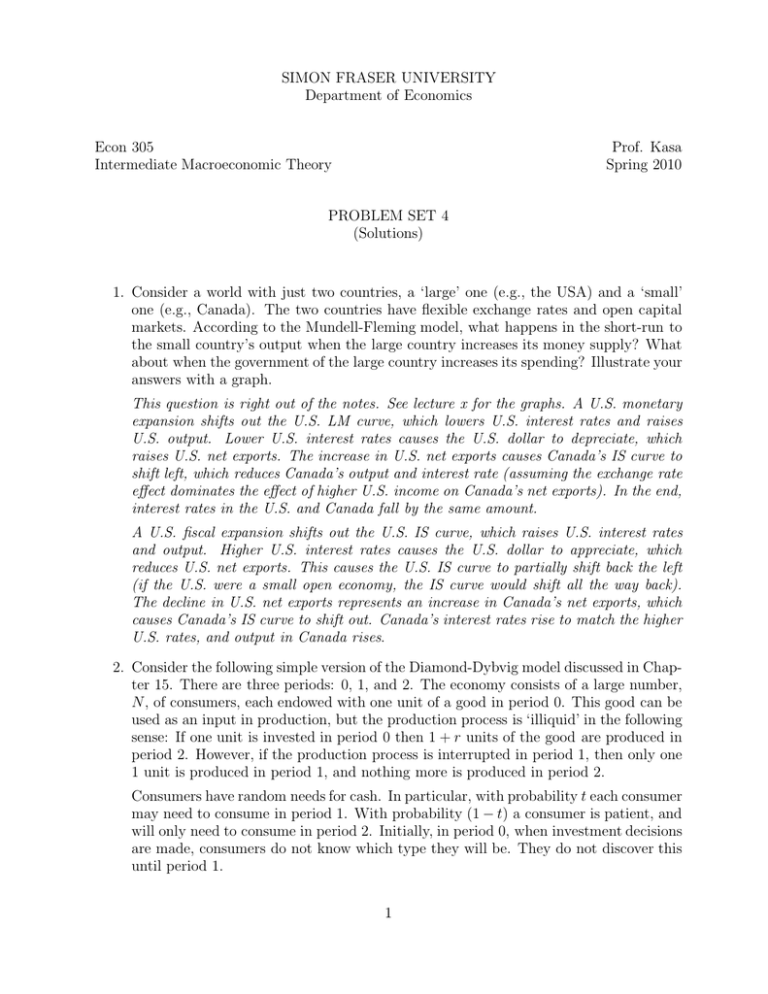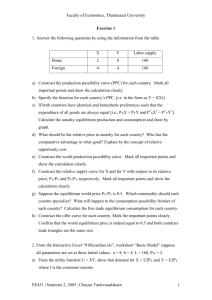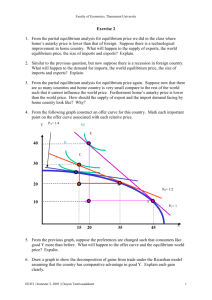SIMON FRASER UNIVERSITY Department of Economics Econ 305 Prof. Kasa
advertisement

SIMON FRASER UNIVERSITY Department of Economics Econ 305 Intermediate Macroeconomic Theory Prof. Kasa Spring 2010 PROBLEM SET 4 (Solutions) 1. Consider a world with just two countries, a ‘large’ one (e.g., the USA) and a ‘small’ one (e.g., Canada). The two countries have flexible exchange rates and open capital markets. According to the Mundell-Fleming model, what happens in the short-run to the small country’s output when the large country increases its money supply? What about when the government of the large country increases its spending? Illustrate your answers with a graph. This question is right out of the notes. See lecture x for the graphs. A U.S. monetary expansion shifts out the U.S. LM curve, which lowers U.S. interest rates and raises U.S. output. Lower U.S. interest rates causes the U.S. dollar to depreciate, which raises U.S. net exports. The increase in U.S. net exports causes Canada’s IS curve to shift left, which reduces Canada’s output and interest rate (assuming the exchange rate effect dominates the effect of higher U.S. income on Canada’s net exports). In the end, interest rates in the U.S. and Canada fall by the same amount. A U.S. fiscal expansion shifts out the U.S. IS curve, which raises U.S. interest rates and output. Higher U.S. interest rates causes the U.S. dollar to appreciate, which reduces U.S. net exports. This causes the U.S. IS curve to partially shift back the left (if the U.S. were a small open economy, the IS curve would shift all the way back). The decline in U.S. net exports represents an increase in Canada’s net exports, which causes Canada’s IS curve to shift out. Canada’s interest rates rise to match the higher U.S. rates, and output in Canada rises. 2. Consider the following simple version of the Diamond-Dybvig model discussed in Chapter 15. There are three periods: 0, 1, and 2. The economy consists of a large number, N , of consumers, each endowed with one unit of a good in period 0. This good can be used as an input in production, but the production process is ‘illiquid’ in the following sense: If one unit is invested in period 0 then 1 + r units of the good are produced in period 2. However, if the production process is interrupted in period 1, then only one 1 unit is produced in period 1, and nothing more is produced in period 2. Consumers have random needs for cash. In particular, with probability t each consumer may need to consume in period 1. With probability (1 − t) a consumer is patient, and will only need to consume in period 2. Initially, in period 0, when investment decisions are made, consumers do not know which type they will be. They do not discover this until period 1. 1 (a) Describe the outcome when each individual acts on his own. Since no output is actually lost by terminating the project early, in the autarky outcome everyone obviously invests in the project. Early types then terminate the project and consume 1 unit. Late types finish the project and consume 1 + r. Ex ante, expected utility is E(U ) = tu(1) + (1 − t)u(1 + r) (b) Describe how a bank could be set-up to exploit the ‘law of large numbers’ to produce potentially better outcomes. Under what conditions on utility functions would the bank produce a Pareto superior outcome? Describe the bank contract that maximizes a typical consumer’s expected utility (i.e., before he learns which type he is). Illustrate this contract with a graph. Note that as r increases, agents face more and more ex ante risk (i.e., their consumption across the 2 states (early vs. late) becomes more and more unequal). If agents are sufficiently risk averse, they can gain by transferring some of their late-state consumption to the early-state consumption. This smoothing out (across states) of consumption raises expected utility. Since not everyone will turn out to be an early-type, a bank can offer to pay early types more than 1 unit in exchange for paying the late-types less than 1 + r units. (Of course, ex post, once an agent finds out he is a late-type, he might want to renege on the contract, but we assume this kind of renegotiation is not possible (see problem 1 in the appendix to chapter 15). The potential gains from the banking contract are illustrated in Figure 15.8 in the textbook, and are calculated analytically for the case of constant relative risk aversion in the notes. The graph and the example show that if agents aren’t too risk averse, then banks don’t improve welfare. (Consider, for example, the case of ‘risk neutrality’, where indifference curves are simply straight lines. Clearly, in this case, no feasible contract can improve welfare relative to autarky. (Of course, as long as the banks are ‘efficient’, they wouldn’t make people worse off either!) (c) Explain why the bank is susceptible to a ‘bank run’ ? The previous outcome isn’t the only possible equilibrium. Since early-types are getting more than 1 unit, if everyone claims to be an early-type there won’t be enough to go around. (Two important assumptions lie behind this conclusion: (1) Banks can’t distinguish between early- and late-types, and (2) Demands for withdrawal are met on a first-come-first-served basis (sometimes called the ‘sequential service constraint’). This means that if everyone tries to withdraw early, and the first ones get their money out at the promised rate, then some people will get nothing. This creates an incentive for late-types to potentially ‘run’ to the bank if they think enough other late types will do likewise. When this happens, there is a bank run, which can produce an outcome that is even worse than autarky (i.e., no investment projects are completed, some people lose all their money, and potentially even some desperate early-types lose their money, due to the sequential service constraint). (d) Now suppose the banking contract includes a ‘suspension of convertibility’ clause, which states that only the first tN depositors in line in period 1 can withdraw their deposits. Will there still be a bank run equilibrium? Why or why not? 2 Note that in the bank run equilibrium, the only reason late-types run to the bank is because they think other late-types might run to the bank, which might mean they do not get paid off. However, if the bank announces ahead of time that they will only pay of tN depositors (no matter who they are, since the bank can’t distinguish between types), then no late-type has an incentive to run to the bank, regardless of what other late-types do. They are guaranteed to get their money if they wait until the following period, so they will wait. As a result, no late-types run to the bank, and the bank run equilibrium is eliminated. As a result, suspension of convertibility can be just as effective as deposit insurance. In practice, of course, banks don’t know exactly what t and N are, so it can be hard to decide exactly when to suspend convertibility. If late-types think the bank might wait too long, then the incentive to run will still exist. 3. Consider the job search model discussed in class and in Chapter 16. In this model, suppose the government introduces an unemployment insurance program in which benefits are financed by taxes on employed workers. Describe the effects of this program on the reservation wage and on the long-run enemployment rate. Use the appropriate graphs to illustrate your answer. This question is right out of the book. A tax on labor income shifts down the Ve (w) curve, and the increase in unemployment benefits shifts up the Vu curve. For both reasons, the reservation wage increases and the equilibrium unemployment rate rises. (See Figures 16.14 and 16.16 in the textbook). 3









